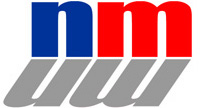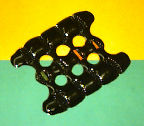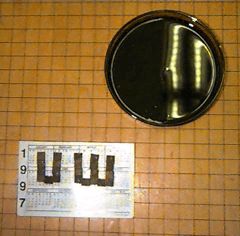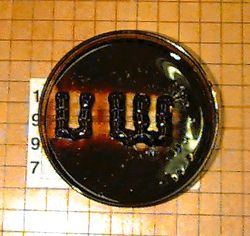

Experiment 2 - Ferrofluid Spikes
Materials
- EMG-905, a mineral oil-based ferrofluid with a saturation magnetization
of 400 gauss obtained from Ferrofluidics
Corporation.
- Strong magnet (cow magnet, bar magnet, or rare earth magnet). Click
here for magnet suppliers.
- Petri dish
Caution! Caution! Caution! Caution! Caution! Caution!
Caution! Caution!
The ferrofluid causes stains and is difficult to remove from skin and
fabrics. Keep the fluid off the magnet. It is virtually impossible to remove
ferrofluid after direct contact with a strong magnet.
Caution! Caution! Caution! Caution! Caution! Caution!
Caution! Caution!
Procedure
- Pour a small amount of ferrofluid into a Petri dish, so that the bottom
of the dish is covered.
- Bring a strong magnet up underneath the Petri dish. Spikes of ferrofluid
will rise up from the surface.
|
|
|
Figure 1 - Click on the arrow on the left to see what happens
when a strong magnet is placed under this dish of ferrofluid.
|
As the magnet is brought closer to the bottom of the Petri dish, first
one spike appears, then several spikes appear, until the spikes appear to
close-pack, with any given spike having six nearest neighbors arranged in
a regular hexagon. The pattern of spikes appears because the ferrofluid arranges
itself along the magnetic field lines of the magnet (as do iron filings).
The number of visible spikes reflects the strength of the magnetic field and
the surface tension of the medium.
- Place a cow magnet horizontally underneath the Petri dish. A pattern
of spikes will appear at the two poles of the magnet. If no spikes are seen,
try using a stronger magnet, as this behavior depends on both the strength
of the magnetic field and the magnetic strength of the ferrofluid.

Figure 2 - Ferrofluid pattern created by an array of three "ringed"
cow magnets.
- Place small, powerful magnets in patterns such as letters underneath the
petri dish. The patterns will transfer to the ferrofluid.


Figure 3 - (left) Place strong magnets in a pattern, such as the "UW"
shown. (right) The magnetic field pattern is manifested in the ferrofluid.
Adapted from Teaching General Chemistry: A Materials Science Companion
by A. B. Ellis, M. J. Geselbracht, B. J. Johnson, G. C. Lisensky, and W. R.
Robinson. Copyright © 1993, American Chemical Society, Washington, DC.
See also On the Surface of Things by F. Frankel and G.M. Whitesides.
Copyright © 1997, Chronicle Books, San Francisco, CA.
Return to Ferrofluid Main Page
Experiment 1 - The Magnetic Liquid
Experiment 3 - The Penny Push
Exploring
the Nanoworld |
MRSEC Nanostructured Interfaces
Copyright © 2006 The Board of Regents of the University
of Wisconsin System.




